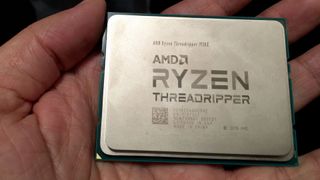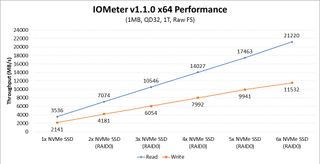Insanely fast NVMe RAID comes to Threadripper
AMD's free driver update for its X399 platform is finally here.

It took AMD a little longer than expected, but the company has now made good on its promise to deliver a free driver update to add RAID support for NVMe drives on Threadripper setups.
The driver arrives a week later than originally planned—AMD delayed the rollout to ensure that everything worked the way it should. When it announced the delay last week, AMD indicated it would be a short wait and that it would arrive "with no strings attached." And so it has.
One thing to note is that these are still beta drivers. For mission critical setups, you may want to wait a bit to see how things shake out. That is especially true if you're planning a speedy RAID 0 configuration. While fast, there is no redundancy in RAID 0—if one of the drives goes bad, you lose the entire array, or at least its data.
The other RAID types that are supported include RAID 1 and RAID 10. In RAID 1 setups, you're trading speed for redundancy by having your data mirrored across multiple drives. RAID 10 offers both speed and redundancy, with the caveat of requiring four or six NVMe drives. In both RAID 1 and RAID 10, drives are hot swappable on Threadripper.
AMD provided some internal benchmarks from running multiple NVMe drives in RAID 0. Have a look:

"In a word: wow. In our own performance testing, we’ve been seeing some blistering results from our test systems—a monstrous 21.2GB/s from six disks in RAID0! But RAID users know that scaling matters, too, and X399 NVMe RAID still looked great in our lab: 6.00X read scaling, and 5.38X write scaling, from one to six disks," AMD said.
Famed overclocker der8auer saw even better results when running eight NVMe SSDs in RAID 0 on an Asus ROG Zenith Extreme motherboard. He combined a pair of Asus Hyper M.2 x16 cards with eight Samsung 960 Pro and Evo SSDs and saw speeds topping 28,376 MB/s. Unfortunately he ended up taking his YouTube video down, but not before Guru3D could grab a few screenies.
The biggest gaming news, reviews and hardware deals
Keep up to date with the most important stories and the best deals, as picked by the PC Gamer team.
Obtaining NVMe RAID support first requires updating your motherboard's BIOS. AMD says it expects all X399 boards to be updated imminently, but the exact date will depend on your motherboard's vendor.
Once that is in place, you can configure your NVMe RAID array from within the BIOS, or with AMD's RAIDXpert2 software.
Paul has been playing PC games and raking his knuckles on computer hardware since the Commodore 64. He does not have any tattoos, but thinks it would be cool to get one that reads LOAD"*",8,1. In his off time, he rides motorcycles and wrestles alligators (only one of those is true).
Most Popular






